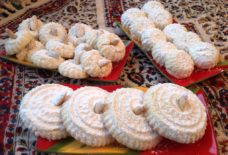New Gallery of Islamic Art to Open at Detroit Institute of Arts (DIA) in February
The Detroit Institute of Arts (DIA) will open its long-awaited new gallery of Islamic art on Sunday, Feb. 28, 2010. The new gallery includes works of art from the Mediterranean region, the Middle East, Central Asia and India, and spans the 7th–early 20th-centuries. The gallery was initially to be part of the museum’s renovation and reinstallation project that was completed in 2007, but was delayed until funding could be secured.
The Islamic collection will be on view in a larger space than was previously allocated. In addition, the new gallery incorporates significant works of art on loan from nine public and private collections. Most of these are long-term loans to the DIA, but manuscripts from collections including the University of Michigan’s Special Collections Library will be rotated in regularly.
DIA Director Graham W. J. Beal believes that giving attention to the collection of Islamic art is crucial for the museum given that the Detroit metropolitan area is home to the largest Middle Eastern population in the United States. “The DIA’s collection of Islamic art allows us to display and teach about the artistic achievements of a great and multifaceted civilization,” said Beal. “We’re excited to highlight some of our Islamic masterpieces and to display some works of art that have never before been on view.”
Planning the gallery provided the opportunity to study the collection and to carry out conservation treatments and scientific analysis, which resulted in a new understanding of some works of art and the rediscovery of important objects that had remained unrecognized for decades. Among them are a very large, rare, early Ottoman mosque candlestick from around 1500, and a 15th-century Timurid cut-tile panel in the shape of a star.
In 2005 the DIA hired Heather Ecker, a specialist in Islamic art, as the curator of Islamic Art and head of the Department of the Arts of Asia and the Islamic World. Among other projects, Ecker has been responsible for researching the collection and planning and installing the new gallery together with a team of interpretive specialists. “The DIA has some superb works of Islamic art—to work with the collection has been a great honor. In the new gallery, visitors will have an opportunity to discover some outstanding treasures, as well as to view some objects that we could not display previously because of their size, such as large carpets,” said Ecker.
In the new galleries, the museum uses the term Islamic art to refer to works of art created in areas governed by Muslims and where Islamic culture has had significant influence. As Islamic art comes from a vast area that includes peoples of diverse cultures, languages, and faiths, both Christian and Jewish sacred manuscripts from the Islamic world will also be exhibited alongside exquisite Islamic manuscripts in an area devoted to sacred writings.
As with the rest of the museum, the galleries are arranged according to the thematic stories the art has to tell. These are expressed in seven major themes: \\\”The Silk Road\\\”; \\\”Masterpieces of Carpet Weaving\\\”; \\\”Art of the Great Empires: Ottoman, Safavid, and Mughal\\\”; \\\”The Medieval Islamic World: Urban Settings and Goods\\\”; \\\”Art of the Mamluks\\\”; \\\”Mediterranean Trade and Spanish Lusterware 1250–1500\\\”; and \\\”Sacred Writings from the Islamic World\\\”.
In keeping with the museum’s visitor-centered approach, multi-layered labels and other interpretive devices will be interspersed in the galleries to help visitors engage with the art. Among these are an interactive “carpet-making” activity, a video of a master calligrapher at work, a large map of the areas represented in the galley and the popular \\\’Eye Spy\\\’ labels.
The DIA began collecting Islamic art in the 1890s. Some of the most important masterpieces in the collection were acquired under Wilhelm Valentiner, director from the 1920s to the 1940s. These works include an exceptional Timurid Qur’an, a splendid enameled bottle made in Syria in the Mamluk period, the largest surviving 17th-century Ottoman velvet summer carpet in the world, and an exquisite, all-silk animal carpet probably made for the Safavid ruler, Shah Tahmasp (r. 1524-76).
Recent acquisitions include an impressive early Iznik blue and white charger from Ottoman Turkey, a Qur’an taken by the Mughal Emperor Shah Jahan from the library of the Uzbek ruler Nadhr Muhammad Khan in 1646, an unusual Mughal painting of mystics seated by a lake, and a small, personal Qur’an, copied by the Ottoman royal calligrapher Mehmed Rasim in 1730, which once belonged to Princess Nazimah Sultan.


